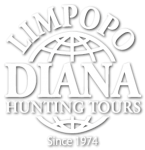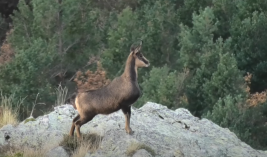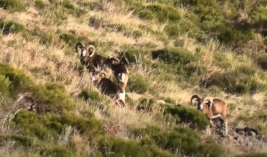France
Hunting in France - a wonderful hunt in beautiful hilly terrain

Highlights
- Excellent Hunting for Small Game, Roebucks, Red Stag and Chamois
- Charming French Countryside in Hilly Terrain
- Old Hunting Traditions
- Excellent Cousine
Hunting in France
Hunting has been an important part of French history and culture for many thousand years, cave paintings showing hunting scenes found in France can be dated to far back into prehistoric times. Hunting was the most important leisure activity for the French kings and aristocracy, many of whom built grandiose hunting lodges in their country estates. French literature and culture also has a rich store of hunting stories and legends.
Today there are 1,350,000 registered hunters in France, who mainly enjoy rough shooting and wild boar hunts. In 2007 the country set a quota of 600,000 roe deer, 13,500 alpine chamois, 3,100 Pyrenean chamois. 3,200 mouflon and 500,000 wild boar. The quota in general is increasing for the different species, largely due to improving game habitats, and the selective shooting policies.
Even though France is one of the world’s most important tourist destinations, practically no hunting has been available to visiting foreign hunters. We are therefore very happy to now be able to offer hunting at a number of different locations in this beautiful country, which also can offer a wealth of other attractions to visitors, which makes it an ideal destination to bring the rest of the family to. Here it is possible to combine high quality hunting with French culture, cuisine, wine and the country’s wonderful countryside.
Video Gallery

-
 Red stag hunting in the Pyrenees
Red stag hunting in the Pyrenees -
 Roebuck hunting in France
Roebuck hunting in France -
 Chamois hunting in the Pyrenees
Chamois hunting in the Pyrenees -
 Mouflon hunting in the Pyrenees
Mouflon hunting in the Pyrenees
Hunting stories
James on Buck Hunting in France
Who says France is just for lovers? It is for hunters, too!
One of the benefits of hunting in Europe is the exposure to history. I got my first taste of Continental hunting served up with a dash of history when I was stationed in Germany with the US Army in the early 1970s. I found that I enjoyed it and have been tramping around the Continent ever since. The best times to stalk roebuck are in the Spring or early Summer ( April through early June) and again at the time of the rut, late July and early August.
My most recent excursions have been to France. The first time in October and on the second trip, June. Before my arrival, all I knew about French hunting was the long history of “parforce” mounted pursuit of stags and the French love for wild boar hunting. This was Gaul after all, the country of Axterix and Obelix! I answered an ad from Diana Hunting Tours a couple of years ago which lead to a three day roebuck stalking session near Auch followed by a few days in the Mid Pyrennes stalking the red stag. Two years later, I returned for roebucks only, with the private hope of bagging a boar.
I got more history than I could digest and some of the most memorable hunting experiences of my life in France.Southen France, in particular, with the Pyrenees often in view. Mix the tribe of the Vascones, the regions of Bearn, Basque Country, Aquitaine, before and after the Roman conquest, the Kingdom of Navarre, and Gascony all together then throw in a couple of famous kings born in Pau, the Good King Henry IV of France and King Karl Johan of Sweden, born Jean Bernadotte,
and you get a historical “soup” that is almost too thick to spoon. For the topping,add the saga of the Mann family escaping from the Nazis by climbing over the Pyrenees and you have a soup for all seasons.
On my first trip, I landed at Toulouse, the home of the Airbus, and hunted the roebuck on the rolling fields and creeks near Auch. It was after the grain harvest and not a “classic” time for roebuck stalking, but the game was plentiful and the hunt was successful. On the second trip, I landed in Pau. The two kings hometown. My guide picked me up the next morning for the short trip to Poudenx and to my hotel. Again, I found great French hospitality, clean comfortable quarters and great food.
Off for an evening stalk with Frederic. Short stop for a test shot. It was about 2”hi, but I thought for shooting from over the hood of the Suzuki, the rifle was on. Then, when the time came, I missed the first buck. Too high. Back to the range. This time I shot twice. Tight group, but 3” high. I clicked the scope down a couple of clicks and was on the bull's eye. I still do not know the science behind the difference in impact from at home 1” high and in Poudenx. Happily, there were no futher problems.
This area was had much more vegetation that at Auch. Oak forests and small meadows and fields. Perfect roe deer country. We always saw many animals, but far more does than bucks. That not withstanding, I did fine. We even managed to discover a Rotte of boar at the edge of a forest one evening. I bagged a big one, but it was a sow with no tusks.
But Fortune is fickle. Sometimes she is with the quarry, and sometimes with the hunter. Up until now, I thought she was giving me the “Fickle Finger of Fate” but work duties took Frederic back to his shop and Lucas took over as the guide. The day before, he had seen a good buck and wanted to take me to see if we could find him.
We stalked over a kilometer, maybe two, always going uphill through the forest. Then we came to a series of small meadows and small corn fields. The corn was about 12 inches high. We stalked extremely carefully. In the tall meadow grass, Lucas saw ears. A doe. She saw us, too, but could not wind us and she soon lay down again. No buck stood up.
On to the edge of the corn field the forest jutted out into the field like an isthmus. This place became our stand with our view to the East. The sun had just gone down. On the very first glassing of the corn field Lucas got a bit excited and set up the shooting sticks. Meanwhile, I could see the buck, too. He was bedded down between the corn rows. I could not see any of this body, but plenty of antler sticking up. I got the rifle settled in on the sticks and said to Lucas, “OK. Get him up.” Lucas yelled. Nothing happened. He yelled again and louder. The ears twitched. The he really yelled very loud and there was movement. I knew from experience, even as athletic and graceful and quick as roe deer are, they do not arise from sleep any too fast. First front legs, then stand, and then stretch. And old fickle Fortune, she was sitting right there on my shoulder. Up he stood. The shot was good and the buck was down.
In 48 years of hunting roe bucks, the one that lay before me in the corn was the best I had ever seen, let alone to have shot. An old buck, with heavy atypical thick beamed antlers. A dream buck. The buck of a lifetime!
- James Lowell Males
Game

Buck/Roe Buck/Roe Deer (Europe)
Scientific Name: Capreolus capreolus Subspecies: We have not included any of the subspecies of Capreolus capreolus, as the authors dissagree about their status as individual subspecies. Distribution: All of Europe except Ireland, Iceland, Southern Spain and Greece. Roe Deer populations are not common to the Mediterranean islands. Habitat: Roe Deer populations are found today in most terrain...
Read more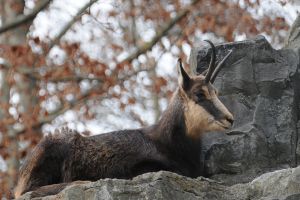
Chamois (Europe)
Scientific Name: Rupicapra rupicapra Subspecies: Rupicapra rupicapra (The Austrian, Swizz, German, French and Italian Alps as well as parts of the former Yugoslavia.) Rupicapra r. pyrenaica (The Pyrenees). Rupicapra r. ornata (The Abruzzian Alps, Italy) Rupicapra r. carpatica (Transsylvania) Rupicapra r. balcanica (Parts of former Yugoslavia) Rupicapra r. caucasica (Kaukasus) Rupicapra r....
Read more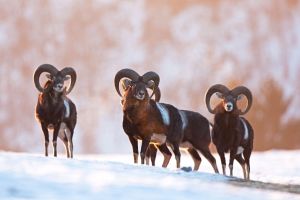
Mouflon (Europe)
Scientific Name: Ovis musimon Subspecies: None in Europe. Distribution: Small isolated groups all over Europe (mostly in fenced in areas). Habitat: Prefers undulating forested areas. Description: Middle sized animal of the sheep family weighing up to 60 kg. (rams), and measuring around 80 cm over the shoulder. General colour dark brown on the back and along the flanks. A black band is...
Read more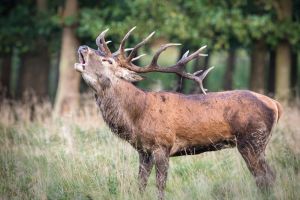
Red Deer/Red Stag (Europe)
Scientific Name: Cervus elaphus Subspecies: We recognise the following subspecies for Europe: East European Red Deer (C.e. montanus) Corsican Red Deer (C.e. corsicanus) Distribution: Red Deer is found in most European countries. Habitat: Woodland, pasture land, wetlands and moorland. Is found in lowlands as well as on high ground and in mountains. Description: Large deer weighing...
Read moreHunting Area

Gers & Pyrenees Atlantique
Områderne for råvildt er i henholdsvis Gers regionen, hvor største by er Auch og i Pyrenees Atlantique, hvor hovedbyen hedder Pau. Fra Toulouse er der ca. 1½ times kørsel til Auch og for områderne ved Pau er der ca. 3-3½ times kørsel til Toulouse. Man kan også flyve til Pau, og så er der kun ca. 1 times kørsel til...
Read more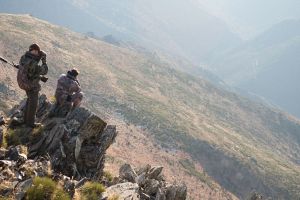
Pyrenees
As far as mountain hunting is concerned, there are several different hunting areas in the Pyrenees. Regardless of whether it is one or the other hunting area, you hunt in a very nice mountain terrain in the Pyrenees. Here there is a very good population of chamois and mouflons, and since the hunting pressure is minimal, good trophies can also be expected, and at prices that are significantly...
Read more
Red Stag hunting in France
In the Pyreneese we can offer two different red deer districts. The first is close to Font-Romeu which is to the west/south west of Perpignan and the other is near Massat, to the south of Toulouse. Here you will enjoy challenging hunting in very beautiful, varied, forest-clad terrain. You can come across both dense forest, clearings, beautiful mountain meadows and barren rocky areas. There is...
Read morePartner
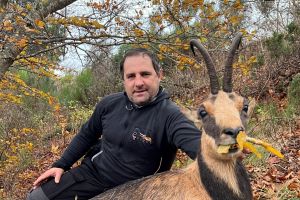
Julien
Our partner, Julien, is both an outfitter and professional hunter, who has been carefully building up his successful company over a number of years. We have enjoyed an excellent working relationship with Julien since 2012, and he has really taken great care of our hunters, giving them some great hunting experiences and some fine trophies. Julien offers roebuck hunting during the...
Read more